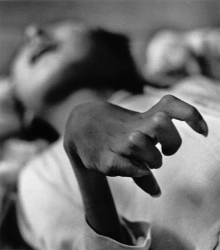
Back داء ميناماتا Arabic Minamata xəstəliyi Azerbaijani Minamata sindrom BS Malaltia de Minamata Catalan Choroba Minamata Czech Minamata-Krankheit German Enfermedad de Minamata Spanish Minamata haigus Estonian Minamata gaitz Basque بیماری میناماتا Persian
| Minamata disease | |
|---|---|
 | |
| The hand of Tomoko Kamimura, who had Minamata disease | |
| Specialty | Toxicology, neurology, psychiatry |
| Symptoms | Ataxia, numbness and muscle weakness |
| Complications | Loss of peripheral vision, and damage to hearing and speech; in extreme cases: insanity, paralysis, coma; can also affect fetuses; see Mercury poisoning for more details |
| Usual onset | Soon after consuming affected seafood |
| Duration | Chronic |
| Causes | Severe mercury poisoning |
| Risk factors | Affected those who consumed fish and shellfish from Minamata Bay |
| Diagnostic method | See mercury poisoning |
| Differential diagnosis | See mercury poisoning |
| Prevention | Proper handling of industrial waste |
| Treatment | See mercury poisoning |
| Medication | See mercury poisoning |
| Prognosis | 35% case fatality rate; for more details see mercury poisoning |
Minamata disease is a neurological disease caused by severe mercury poisoning. Signs and symptoms include ataxia, numbness in the hands and feet, general muscle weakness, loss of peripheral vision, and damage to hearing and speech. In extreme cases, insanity, paralysis, coma, and death follow within weeks of the onset of symptoms. A congenital form of the disease affects fetuses in the womb, causing microcephaly, extensive cerebral damage, and symptoms similar to those seen in cerebral palsy.
Minamata disease was first discovered in the city of Minamata, Kumamoto Prefecture, Japan, in 1956, hence its name. It was caused by the release of methylmercury in the industrial wastewater from a chemical factory owned by the Chisso Corporation, which continued from 1932 to 1968. It has also been suggested that some of the mercury sulfate in the wastewater was also metabolized to methylmercury by bacteria in the sediment.[1] This highly toxic chemical bioaccumulated and biomagnified in shellfish and fish in Minamata Bay and the Shiranui Sea, which, when eaten by the local population, resulted in mercury poisoning. The poisoning and resulting deaths of both humans and animals continued for 36 years, while Chisso and the Kumamoto prefectural government did little to prevent the epidemic. The animal effects were severe enough in cats that they came to be named as having "dancing cat fever".[2]
As of March 2001, 2,265 victims had been officially recognized as having Minamata disease[3] and over 10,000 had received financial compensation from Chisso.[4] By 2004, Chisso had paid $86 million in compensation, and in the same year was ordered to clean up its contamination.[5] On March 29, 2010, a settlement was reached to compensate as-yet uncertified victims.[6]
A second outbreak of Minamata disease occurred in Niigata Prefecture in 1965. The original Minamata disease and Niigata Minamata disease are considered two of the Four Big Pollution Diseases of Japan.
- ^ Hamdy MK, Noyes OR (1975). "Formation of Methyl Mercury by Bacteria". Appl. Microbiol. 30 (3): 424–432. doi:10.1128/AEM.30.3.424-432.1975. PMC 187198. PMID 1180551. and references therein.
- ^ Withrow SJ, Vail DM (2007). Withrow and MacEwen's Small Animal Clinical Oncology (4th ed.). St. Louis, MO: Elsevier. pp. 73–4. ISBN 978-0-721-60558-6.
- ^ Official government figure as of March 2001. See "Minamata Disease: The History and Measures, ch2"
- ^ See "Minamata Disease Archives" Archived 2016-03-03 at the Wayback Machine, Frequently asked questions, Question 6
- ^ Jane Hightower (2008). Diagnosis Mercury: Money, Politics and Poison, Island Press, p. 77.
- ^ "Agreement reached to settle Minamata suit", Asahi Shimbun news, 31 March 2010, retrieved 1 April 2010
© MMXXIII Rich X Search. We shall prevail. All rights reserved. Rich X Search